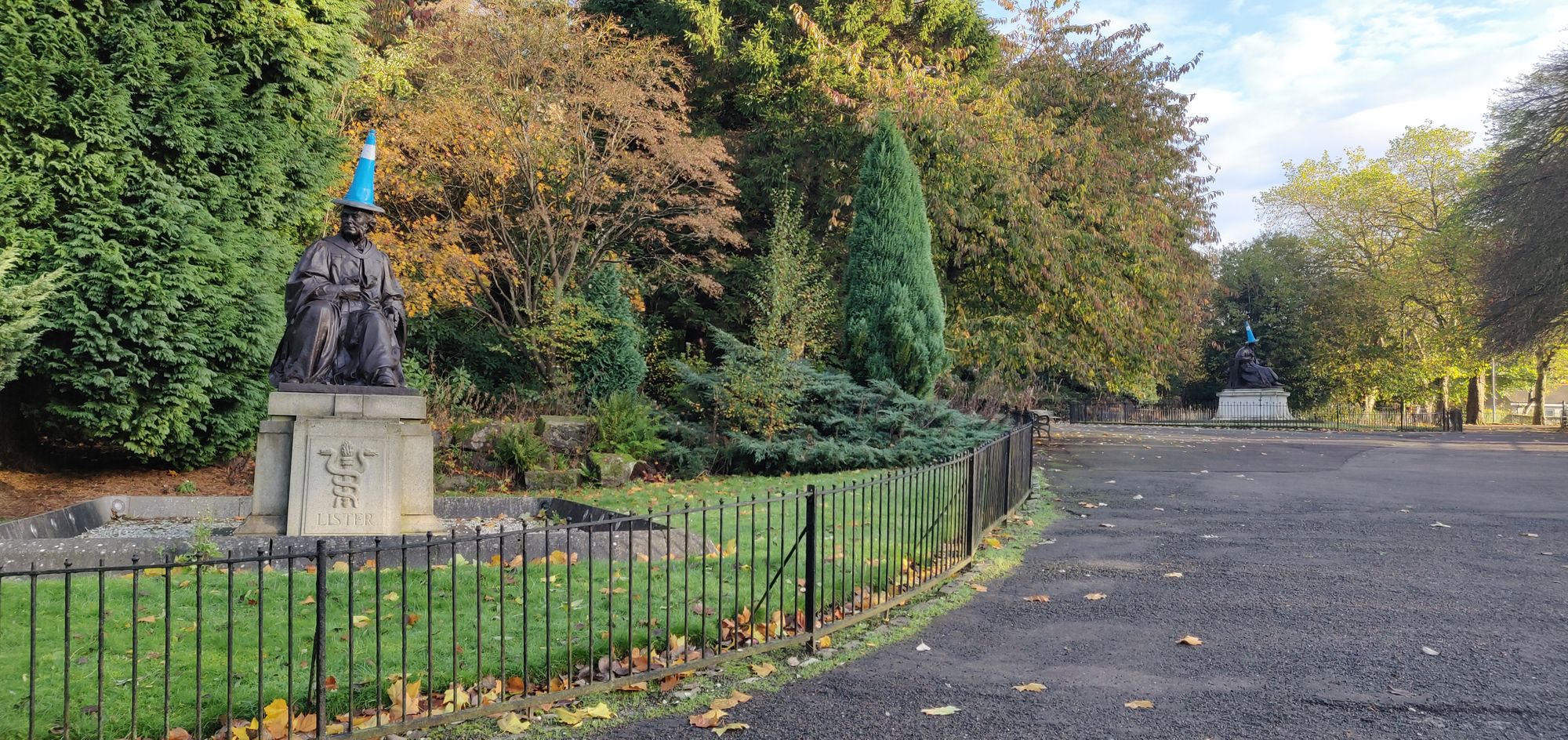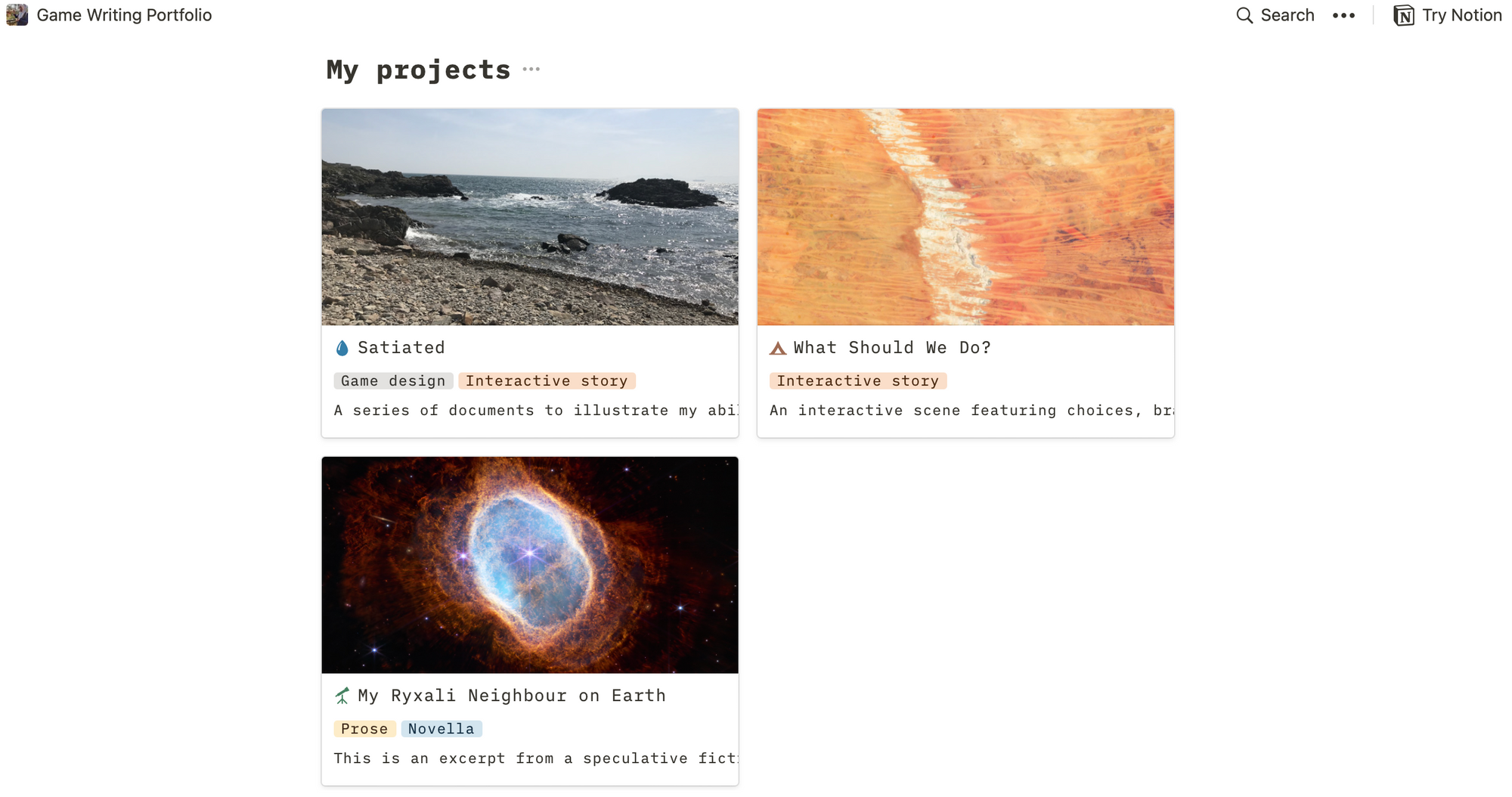
How To: Your First Game Writing Portfolio
This is an additional article from our wonderful 2022 Game Writing Intern Halima Hassan. As part of the internship (and as well as working on the studio's upcoming game) Halima also went through a mentoring process with our Studio Lead Hannah Nicklin. Early on they identified together that Halima would like to conclude the mentorship by working towards a portfolio which she could use professionally. Which takes us to now! We hope that you enjoy this insight into Halima's journey. And stay tuned 'til the end for a bonus extract from Writing For Games on designing your own portfolio.
Halima's Journey
Part of the writing internship included mentoring with Studio Lead Hannah Nicklin, and during our first mentoring session we defined some of the goals I wanted out of the experience.
One of those goals was to have a portfolio assembled at the end to showcase some of my writing and experience.
I did not have a portfolio entering this experience, only a handful of articles and stories that I mostly kept to myself and shared with folks when asked. From entering a creative space from a non-creative background, and speaking with folks who have dwelled in here for some time, I came to understand the value of a public collection of work; something for others to peruse, that establishes and confirms you as your chosen creative.
Practical and Personal Considerations
Having mostly only written for myself and to myself prior to this experience, I found the idea of a portfolio kind of tricky and - unexpectedly - uncomfortable.
There were the practical considerations: What pieces should I choose? Should I write something new? How can I assemble something that shows not only what I’ve done, but also what I have the potential to do?
Then there were the more personal concerns: What if these pieces don’t actually do me any justice? What does that even mean? Why is it so hard to be perceived!?

I knew I wanted a games writing portfolio, specifically. Although I have only been writing for video games and interactivity for the past year, it has become an area I would like to explore even more.
I worked with Hannah to create my portfolio and began by looking at the portfolios of peers that I really admired, and identifying what I liked about them. I found myself drawn to simple and personal presentations of work.
The Right Tools
Studios are constantly pushing what narrative in video games looks like, but there are a few skills that I learnt from Hannah that I should try and demonstrate through the pieces I choose for my portfolio: writing a range of dialogue (barks and conversations), familiarity with a game writing tool (e.g. Inky or Twine - although understanding that companies might have custom tools that was more about demonstrating tool literacy), adapting your writing to different genres or house styles and world building.
Each piece would be presented alongside a few lines describing intent and the skills I was highlighting within the piece of work.
I decided to write some new pieces for my portfolio using exercises from Writing for Games as a guide, since I cannot share any of my recent work yet. I knew quickly that I wanted to showcase some of my speculative writing and my interest in folklore and mythology, specifically Somali folklore.
This, alongside the reminder from Hannah that: "your practice belongs to you", led me to a key realisation about this entire portfolio creation and sharing process that helped me feel less weird.
The portfolio is a never ending project and will be revisited and updated as time goes on. What will always be important to me is that whatever iteration of it exists online is true.
By true, I mean meaningful to me; it is important that I'm proud of what I put out there. The rest is extra. And with that foundation, I knew I wanted to draw on my heritage for inspiration for some of the pieces, because my background is important to me as a person.
I enjoy exploring relationships and human emotions in surreal contexts, so I made sure to include that, too.

I’ve collated my portfolio on Notion because I wanted a simple and clear setup that is easy to update (and the site is free, so added bonus!).
I settled on three projects: the first, Satiated, was assembled using Writing for Games as a guide, specifically, exercises 2, 4, 11 for those with access to the book (I recommend trying to request it through a library).
I created a game design document for the interactive story I had in mind, and within it, linked character sheets and scenes of dialogue. I also rewrote the same scene in the style of a modern Western as a challenge to myself (my love for Red Dead Redemption 2 rears its head again).

The second project in the portfolio is the interactive scene that I first wrote for the second stage of the writing internship application process.
All the dialogue/interactive scenes are written using Ink markup and can be played in the browser: I exported the Inky scripts as HTML and I’m hosting them on a Neocities site, also free! Stories written in Inky can also be exported and hosted on itch.io, I chose Neocities as I was already building a static page on there.
I chose Inky as that is the tool used by the studio for their upcoming project, and one I became comfortable using during my internship.
I also think it is quite accessible and I believe it is easy to integrate with Unity, so a good option for people interested in interactive fiction and game developers.
Finally, I included a sample of prose, an excerpt from a novella I'm working on. The idea of this novella came from a seed given to me by the teacher of a short story writing course I took a few years ago.

Ultimately, I enjoyed putting this portfolio together, even with the mixed feelings that I started with. Trying to promote myself in this way is new to me (and many others entering this industry).
I have by no means figured it all out, but I hope in sharing my thought process there is something helpful here for folks in a similar position to me. I’m grateful for the support I got from Hannah and from the lovely folk who helped me edit pieces and check the portfolio for coherency.
So here it is, my game writing portfolio; if you take the time to give it a look, thank you, I really do appreciate it.
If you're someone who often reads game writing portfolios, or are an experienced peer, feel free to give me feedback, I’m happy to keep working at it. In the meantime, I’ll be over here, writing and trying my best not to overthink!
Thanks to Halima for writing up and sharing her journey with us all, and now to wrap up, a short extract from Writing for Games which summarises some key things to think about when putting together your own game writing portfolio. A large part of Part 3 can also be used to produce work that can go into this format so do consider finding the book in your local library if you think it might be useful.
Extract From: Tools for Finishing (Writing for Games)
One of the most useful things you can do as a writer for games moving to a new project (or looking to) is have a clear, accessible and easy to read portfolio website. Whether it’s built in Tumblr, Squarespace, Wordpress or from hand, it doesn’t matter. It does need to work well on mobile, and in most common browsers. And you need a URL that you can still be proud of when you’re ten years down the line.
You might still need to put together custom portfolios for certain applications or studios, but in general a public portfolio site linked to an active twitter profile is one of the most effective means of reaching out for work.
What makes a good game writing portfolio? When I’m recruiting writers, at minimum I want to see:
Landing Page
A landing page with a picture, a short summary of you and your experience, and 3 clear representative writing samples. A clear ‘contact’ button with an actual email address.
About Page
An About page which is a longer description of you and your practice, plus a CV-like list of crucial credits, qualifications and experience.
Portfolio Highlights
Writing samples: one short dialogue sample which shows you have a good ear for character, line length, naturalism etc., one story-led design proposal, one interactive writing sample including well-written choices (a video if not playable in-browser). Each sample should have a clear statement explaining the brief, context from which it’s excerpted, and any awards or review quotes or accolades associated with the work. If you’ve worked with/for someone on the sample, ask for an endorsement quote from your manager/collaborator you can include on the page.
Wider Portfolio
A larger portfolio section with more examples of work – if you’ve worked in different mediums it might be useful to set-up a subdomain which is games.yournamewebsite.com as the ‘home’ for all of this, and link to your ‘full’ website with poetry and fiction and TV writing from the root domain. Have a clear ‘games writing portfolio’ link from that root portfolio though.
Optional
Blog, link to social media.
These portfolio pieces are crucially all things you don’t need previous experience to work on. You can, in fact, take a year to develop pieces for your portfolio (see next section for a possible model for this).
And as I said – this is what I want to see – but it’s also worth taking a look at people a couple of years ahead of you career-wise in areas you’re interested in working in, and seeing what they provide (don’t use very established writers as an example, because by the point someone is operating on an established reputation, they will have outdated portfolios.)
One very useful thing you can reach out to mentors for is a portfolio review. If the kinds of companies you want to work for aren’t advertising entry-level positions, reaching out for a couple hour’s portfolio review as a piece of mentoring from their story team could be a very valuable insight into what they’d want to see and a way to get them to be aware of you, maybe even recommend you to others.
Finally, don’t be afraid of cold-outreach. Some people hate receiving cold-emails, which is fine, they probably won’t remember you because they won’t read it. But occasionally taking the time to do some cold-applications is good practice and might result in making someone aware of you when they are recruiting, or someone else is.
We hope this short extract was useful, thanks for reading!
